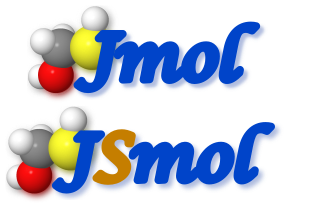The Protein Data Bank (PDB) is a database for the three-dimensional structural data of large biological molecules such as proteins and nucleic acids, which is overseen by the Worldwide Protein Data Bank (wwPDB). These structural data are obtained and deposited by biologists and biochemists worldwide through the use of experimental methodologies such as X-ray crystallography, NMR spectroscopy, and, increasingly, cryo-electron microscopy. All submitted data are reviewed by expert biocurators and, once approved, are made freely available on the Internet under the CC0 Public Domain Dedication. Global access to the data is provided by the websites of the wwPDB member organisations.
Force spectroscopy is a set of techniques for the study of the interactions and the binding forces between individual molecules. These methods can be used to measure the mechanical properties of single polymer molecules or proteins, or individual chemical bonds. The name "force spectroscopy", although widely used in the scientific community, is somewhat misleading, because there is no true matter-radiation interaction.

In molecular biology and biotechnology, a fluorescent tag, also known as a fluorescent label or fluorescent probe, is a molecule that is attached chemically to aid in the detection of a biomolecule such as a protein, antibody, or amino acid. Generally, fluorescent tagging, or labeling, uses a reactive derivative of a fluorescent molecule known as a fluorophore. The fluorophore selectively binds to a specific region or functional group on the target molecule and can be attached chemically or biologically. Various labeling techniques such as enzymatic labeling, protein labeling, and genetic labeling are widely utilized. Ethidium bromide, fluorescein and green fluorescent protein are common tags. The most commonly labelled molecules are antibodies, proteins, amino acids and peptides which are then used as specific probes for detection of a particular target.

A triose is a monosaccharide, or simple sugar, containing three carbon atoms. There are only three possible trioses: the two enantiomers of glyceraldehyde, which are aldoses; and dihydroxyacetone, a ketose which is symmetrical and therefore has no enantiomers.

A biomolecule or biological molecule is loosely defined as a molecule produced by a living organism and essential to one or more typically biological processes. Biomolecules include large macromolecules such as proteins, carbohydrates, lipids, and nucleic acids, as well as small molecules such as vitamins and hormones. A more general name for this class of material is biological materials. Biomolecules are an important element of living organisms, those biomolecules are often endogenous, produced within the organism but organisms usually need exogenous biomolecules, for example certain nutrients, to survive.

Stretching is a form of physical exercise in which a specific muscle or tendon is deliberately expanded and flexed in order to improve the muscle's felt elasticity and achieve comfortable muscle tone. The result is a feeling of increased muscle control, flexibility, and range of motion. Stretching is also used therapeutically to alleviate cramps and to improve function in daily activities by increasing range of motion.
Affinity chromatography is a method of separating a biomolecule from a mixture, based on a highly specific macromolecular binding interaction between the biomolecule and another substance. The specific type of binding interaction depends on the biomolecule of interest; antigen and antibody, enzyme and substrate, receptor and ligand, or protein and nucleic acid binding interactions are frequently exploited for isolation of various biomolecules. Affinity chromatography is useful for its high selectivity and resolution of separation, compared to other chromatographic methods.

Flavin mononucleotide (FMN), or riboflavin-5′-phosphate, is a biomolecule produced from riboflavin (vitamin B2) by the enzyme riboflavin kinase and functions as the prosthetic group of various oxidoreductases, including NADH dehydrogenase, as well as a cofactor in biological blue-light photo receptors. During the catalytic cycle, a reversible interconversion of the oxidized (FMN), semiquinone (FMNH•), and reduced (FMNH2) forms occurs in the various oxidoreductases. FMN is a stronger oxidizing agent than NAD and is particularly useful because it can take part in both one- and two-electron transfers. In its role as blue-light photo receptor, (oxidized) FMN stands out from the 'conventional' photo receptors as the signaling state and not an E/Z isomerization.

Jmol is computer software for molecular modelling chemical structures in 3-dimensions. Jmol returns a 3D representation of a molecule that may be used as a teaching tool, or for research e.g., in chemistry and biochemistry.

In biochemistry, a conformational change is a change in the shape of a macromolecule, often induced by environmental factors.
Biomolecular engineering is the application of engineering principles and practices to the purposeful manipulation of molecules of biological origin. Biomolecular engineers integrate knowledge of biological processes with the core knowledge of chemical engineering in order to focus on molecular level solutions to issues and problems in the life sciences related to the environment, agriculture, energy, industry, food production, biotechnology and medicine.
The Cowboy and the Lady is a 1938 American Western romantic comedy film directed by H.C. Potter, and starring Gary Cooper and Merle Oberon. Written by S.N. Behrman and Sonya Levien, based on a story by Frank R. Adams and veteran film director Leo McCarey, the film is about a beautiful socialite masquerading as a maid who becomes involved with an unpretentious, plain-spoken cowboy who is unaware of her true identity. The Cowboy and the Lady won an Academy Award for Sound Recording, and was nominated for Original Score and Original Song.

Chlorisondamine is a nicotinic acetylcholine receptor antagonist that produces both neuronal and ganglionic blockade.
Target proteins are functional biomolecules that are addressed and controlled by biologically active compounds. They are used in the processes of transduction, transformation and conjugation. The identification of target proteins, the investigation of signal transduction processes and the understanding of their interaction with ligands are key elements of modern biomedical research. Since the interaction with target proteins is the molecular origin of most drugs, their particular importance for molecular biology, molecular pharmacy and pharmaceutical sciences is obvious. Target proteins control the action and the kinetic behavior of drugs within the organism. The elucidation of structure, conformational signaling and catalytic properties of particular target proteins facilitates a rational design of drugs and biotechnological processes. Known as biologicals, target proteins can also be drugs by themselves when their modification and formulation is emphasized within the pharmaceutical sciences. Finally, target protein - inducer interactions can be exploited for biomolecular transcription regulating systems in order to control for example gene therapeutic approaches.
In chemistry, topology provides a way of describing and predicting the molecular structure within the constraints of three-dimensional (3-D) space. Given the determinants of chemical bonding and the chemical properties of the atoms, topology provides a model for explaining how the atoms ethereal wave functions must fit together. Molecular topology is a part of mathematical chemistry dealing with the algebraic description of chemical compounds so allowing a unique and easy characterization of them.

National Highway 60 is a primary national highway in India, connecting Pune and Dhule in the state of Maharashtra. Previously this route was numbered as NH 3 and NH 50. The total length of NH 60 is 360.6 km (224.1 mi). Dhule to Nashik stretch of this route is part of Asian Highway 47.
The hierarchical editing language for macromolecules (HELM) is a method of describing complex biological molecules. It is a notation that is machine readable to render the composition and structure of peptides, proteins, oligonucleotides, and related small molecule linkers.
Biomolecules and Biomedicine is a bimonthly peer-reviewed open-access medical journal published by the Association of Basic Medical Sciences of Federation of Bosnia and Herzegovina. The journal covers research across the spectrum of pre-clinical studies, translational medicine, and clinical research. It was established in 1998 as the Bosnian Journal of Basic Medical Sciences, obtaining its current name in 2023.








